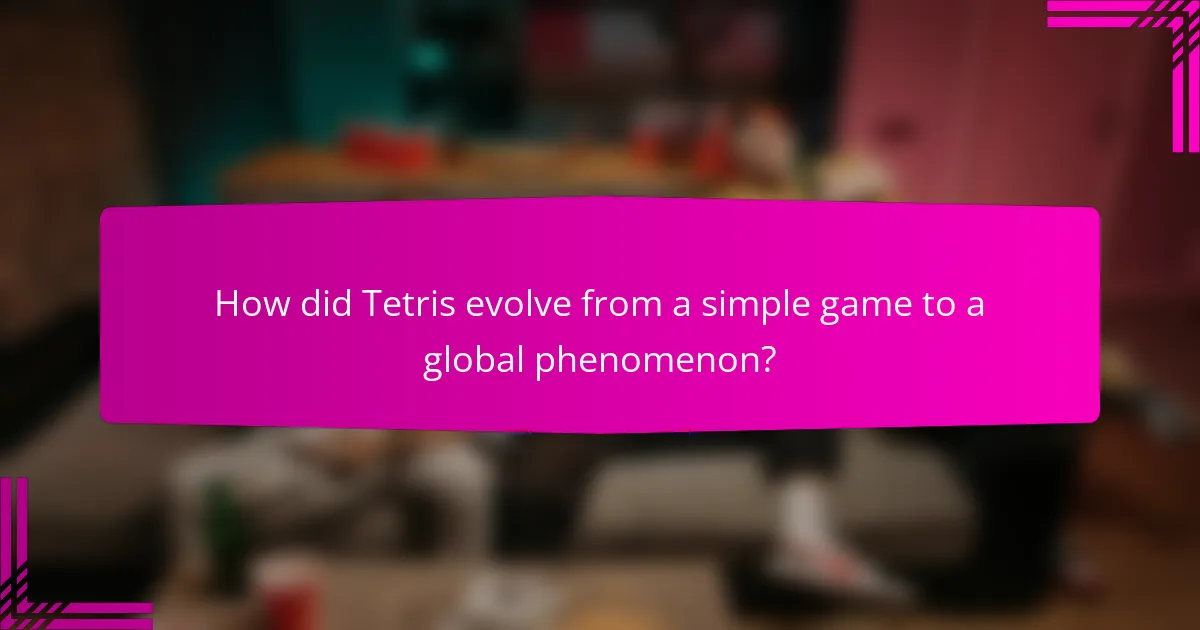Tetris enhances cognitive functions and relieves stress through its engaging gameplay. This article explores its history, innovative gameplay mechanics, and significant cultural impact across generations. Discover how Tetris evolved from a simple block-stacking game to a global phenomenon, influencing various media and competitive gaming. Learn about unique adaptations and the psychological benefits that contribute to its lasting popularity.

How did Tetris evolve from a simple game to a global phenomenon?
Tetris evolved from a simple game to a global phenomenon through innovative gameplay mechanics and cultural integration. Initially created by Alexey Pajitnov in 1984, Tetris featured basic block-stacking gameplay that appealed to players worldwide. As technology advanced, it transitioned from arcade machines to home consoles and mobile devices, increasing accessibility.
The game’s unique attributes, such as the iconic Tetrimino shapes and addictive nature, fostered a competitive community. Tetris influenced various media, inspiring art, music, and even scientific studies on spatial reasoning. Its cultural impact is evident in global tournaments and merchandise, solidifying its status as a timeless classic.
What were the key milestones in Tetris’ development?
Tetris underwent several key milestones that shaped its development. In 1984, Alexey Pajitnov created Tetris in the Soviet Union, introducing the iconic gameplay mechanics. By 1989, the game gained international popularity when it was released for the Game Boy, significantly contributing to its cultural impact. The 1996 launch of Tetris on mobile platforms further expanded its reach, making it accessible to a broader audience. In 2006, Tetris was recognized by the World Video Game Hall of Fame, solidifying its status as a classic.
Which platforms popularized Tetris across generations?
Tetris gained popularity across generations through various platforms, including home consoles, handheld devices, and mobile applications. The original Game Boy version in 1989 introduced the game to a wider audience. Subsequent releases on platforms like NES, PlayStation, and Xbox continued its legacy. Mobile adaptations, particularly on iOS and Android, further expanded its reach. The game’s availability on PC and online platforms has maintained its relevance, appealing to both nostalgic players and new fans.
How did Tetris influence the gaming industry?
Tetris significantly influenced the gaming industry by popularizing puzzle mechanics and shaping game design. Its innovative gameplay introduced concepts like spatial reasoning and quick decision-making, which many games adopted. The game’s success demonstrated the viability of simple yet engaging mechanics, leading to a surge in puzzle games. Tetris also established the importance of iconic music and visual design, influencing the aesthetic direction of future titles. Its cultural impact is evident in its recognition as a classic, inspiring adaptations across various platforms and media.

What are the fundamental gameplay mechanics of Tetris?
Tetris gameplay mechanics center on arranging falling tetrominoes to clear lines. Players manipulate shapes using rotation and lateral movement, aiming to create horizontal lines without gaps. Each cleared line earns points and contributes to game progression. Unique attributes include the “T-spin” move, which offers bonus points for specific configurations. The game’s speed increases over time, adding challenge and urgency.
How do the Tetriminos function in gameplay?
Tetriminos function as the primary game pieces in Tetris, each with unique shapes and rotation mechanics. Players manipulate these geometric blocks to form complete lines across the playfield, which then disappear, earning points. The game’s challenge increases as the pieces fall faster over time, requiring quick thinking and spatial awareness. Each Tetrimino can be rotated and moved horizontally, allowing for strategic placement to maximize line completion.
What scoring systems are used in Tetris?
Tetris scoring systems include various methods that reward players based on their performance. The primary scoring methods are line clears, Tetris bonuses, and combos.
1. **Line Clears**: Players earn points for each line cleared, with more points for clearing multiple lines simultaneously.
2. **Tetris Bonus**: Clearing four lines at once grants a significant bonus, encouraging players to aim for this achievement.
3. **Combos**: Consecutive line clears without any gaps increase the score, rewarding skillful play.
4. **Back-to-Back**: Achieving multiple Tetris bonuses in a row yields additional points, promoting strategic gameplay.
5. **Soft Drop and Hard Drop**: Points are awarded for each drop type, with hard drops granting more points.
6. **Level Multiplier**: As levels increase, the score multiplier boosts points earned, enhancing the challenge and reward.
These scoring mechanisms contribute to the game’s competitive nature and player engagement.
How does the game progression impact player experience?
Game progression significantly enhances player experience by providing increasing challenges and engagement. In Tetris, as players advance, the speed and complexity of falling blocks escalate, demanding quicker reflexes and strategic thinking. This dynamic keeps players invested, as they strive to improve their skills and achieve higher scores. The gradual increase in difficulty creates a rewarding sense of accomplishment, fostering a deeper connection to the game. Additionally, the iconic music and visual feedback during progression amplify emotional engagement, making each level feel significant.
![]()
Why is Tetris considered a cultural icon?
Tetris is considered a cultural icon due to its revolutionary gameplay and lasting impact on gaming culture. Since its release in 1984, Tetris has influenced game design and inspired countless adaptations. The simple mechanics of fitting falling blocks together resonate universally, promoting cognitive skills and strategic thinking. Tetris has transcended generations, becoming a symbol of gaming nostalgia and creativity. Its presence in various media, including art, music, and competitive gaming, solidifies its status as a cultural phenomenon.
How has Tetris influenced art and music?
Tetris has significantly influenced art and music through its iconic visuals and soundscapes. The game’s minimalist design inspired various artists to explore pixel art and digital aesthetics. Its soundtrack, particularly the “Korobeiniki” theme, has been remixed and reinterpreted across multiple genres, impacting contemporary music. Tetris has also been featured in numerous art installations, showcasing its cultural relevance. The unique combination of gameplay and audiovisual elements has made Tetris a lasting symbol in both artistic and musical realms.
What role does Tetris play in competitive gaming?
Tetris plays a significant role in competitive gaming by fostering strategic thinking and quick reflexes. Its iconic gameplay mechanics, such as piece rotation and line clearing, create a dynamic environment for players. The competitive scene has evolved, with tournaments showcasing elite players and innovative formats. Tetris has influenced game design and culture, serving as a benchmark for puzzle games and competitive formats worldwide. Its enduring popularity highlights its impact on the gaming community and competitive landscape.
How do different cultures engage with Tetris?
Different cultures engage with Tetris through unique adaptations and community events. In Japan, Tetris is celebrated in competitive tournaments, emphasizing skill and strategy. In Russia, it reflects national pride, with historical significance tied to its origin. Western cultures often focus on casual play, integrating Tetris into social gatherings. In South Korea, it has evolved into an eSports phenomenon, showcasing professional players. Each culture’s engagement highlights Tetris’ versatility and enduring appeal across generations.

What are the psychological effects of playing Tetris?
Playing Tetris can significantly enhance cognitive functions and relieve stress. Research shows it improves spatial skills and problem-solving abilities. The game’s repetitive nature can also lead to a meditative state, promoting relaxation. Additionally, players often experience a phenomenon known as the “Tetris effect,” where they visualize Tetris shapes in real life, indicating deep mental engagement. These psychological benefits contribute to Tetris’s enduring popularity and cultural impact.
How does Tetris impact cognitive skills?
Tetris enhances cognitive skills by improving spatial awareness, problem-solving abilities, and reaction times. Research shows that playing Tetris can increase gray matter density in the brain, which is linked to enhanced cognitive functions. The game’s mechanics require players to think strategically and anticipate future moves, fostering critical thinking skills. Additionally, studies indicate that Tetris can help with mental rotation tasks, a key component of spatial reasoning.
What are the therapeutic benefits of Tetris?
Tetris offers therapeutic benefits including improved cognitive function, enhanced problem-solving skills, and stress relief. Research indicates that playing Tetris can increase gray matter density in the brain, promoting better mental health. Additionally, it serves as a distraction from negative thoughts, aiding in anxiety reduction. Regular gameplay has been linked to increased spatial awareness and memory retention, making it a valuable tool for mental fitness.

What unique adaptations of Tetris exist in various formats?
Unique adaptations of Tetris exist across various formats, showcasing innovative gameplay and mechanics. For instance, Tetris 99 introduces a battle royale element, where players compete against 98 others. The mobile version, Tetris Blitz, features time-limited power-ups and a fast-paced scoring system. In contrast, Tetris Effect emphasizes immersive visuals and music synchronization, creating a unique sensory experience. Additionally, the physical adaptation of Tetris, such as Tetris: The Grand Master, includes competitive elements and advanced player mechanics. Each format highlights distinct attributes, enhancing the Tetris legacy while appealing to diverse audiences.
How do mobile versions of Tetris differ from traditional gameplay?
Mobile versions of Tetris often differ from traditional gameplay by incorporating touch controls and faster-paced levels. These adaptations enhance accessibility and engagement for players on portable devices. Mobile Tetris frequently includes features like daily challenges and online multiplayer, which are less common in traditional formats. Additionally, graphics and sound effects may be updated to suit modern devices, improving the overall user experience.
What are the unique features of Tetris 99?
Tetris 99 features a unique battle royale format where 99 players compete simultaneously. Each player clears lines to send garbage blocks to opponents, creating a strategic gameplay experience. The game introduces a KO system, allowing players to target others, enhancing competition. Additionally, it includes a leaderboard, showing player rankings in real-time. The game also features a dynamic and visually engaging presentation, incorporating themes from classic Tetris games.

How has Tetris maintained relevance in modern gaming?
Tetris has maintained relevance in modern gaming through its timeless gameplay, innovative adaptations, and cultural significance. The game’s simple mechanics allow for accessibility, attracting both new players and nostalgic fans. Regular updates and mobile versions keep it fresh, while its presence in esports highlights its competitive appeal. Tetris has influenced game design and continues to be a reference point in discussions about gaming history. Its enduring popularity is a testament to its unique blend of challenge and strategy, appealing to a diverse audience across generations.
What innovations have been introduced in recent Tetris releases?
Recent Tetris releases have introduced several innovations enhancing gameplay and user experience. Notably, “Tetris Effect” incorporates immersive visuals and music synchronization, creating a unique sensory experience. “Tetris 99” introduces battle royale mechanics, allowing players to compete against 98 others in real-time. Cross-platform play has been expanded, enabling users to connect across different devices. Additionally, new modes like “Tetris Friends” foster social play and community engagement. These innovations reflect a blend of traditional gameplay with modern gaming trends, enhancing Tetris’s cultural impact.
How do community-driven events keep Tetris alive?
Community-driven events keep Tetris alive by fostering engagement, collaboration, and competition among players. These events create a vibrant social atmosphere that attracts both new and veteran players. They often feature tournaments, which showcase skill and strategy, enhancing the game’s appeal. Furthermore, events promote community-building through shared experiences and creativity, such as fan art and custom levels. This ongoing interaction ensures Tetris remains relevant and evolves, maintaining its cultural impact over time.
What are the best practices for mastering Tetris gameplay?
To master Tetris gameplay, focus on strategic placement, quick decision-making, and anticipating future blocks. Utilize techniques like T-spins and stacking to maximize scoring and efficiency. Practice regularly to improve speed and adaptability, which are crucial for higher levels of play. Understanding the game’s mechanics, such as soft and hard drops, enhances overall performance.
